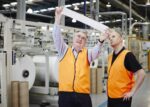New $18M partnership building digital tech for safer workplaces
CSIRO, Australia’s national science agency, will join forces with five universities to keep Aussies safe at work using the latest digital technologies. The $18 million Tech4HSE program unites leading researchers in emerging technologies such as generative and immersive artificial intelligence (AI), augmented reality and cybersecurity, to develop tech to aid those working in dangerous environments. The program is led by CSIRO’s data and digital arm, Data61, and the University of Queensland (UQ). Swinburne, UNSW, Curtin and ANU have also signed up as partners. Science Director of Data61, Professor Aaron Quigley, said the technologies developed will support health, safety and environmental (HSE) objectives across a wide range of industries. “Whether they’re working with electrical equipment, heavy machinery or on our roads, millions of Australians put themselves in harm’s way every day to help and serve others,” Prof. Quigley said. “We’re bringing the best researchers in the nation together to help get everyone home safely, by creating advanced digital tools for training, identifying and monitoring hazards, and planning responses and actions.” According to the Australian Bureau of Statistics, 497,300 Australians suffered from a work-related injury or illness in 2021-22. All participating institutions are contributing funding and research expertise to the program, with UQ administering the funding. UQ Tech4HSE Science Lead Dr Mashhuda Glencross said these projects present an exciting opportunity to make an impactful difference. “The innovative technologies we are researching and developing in this initiative are aimed at supporting the safety of Australians during disasters and when working in potentially hazardous environments,” Dr Glencross said. Prototypes will be built over five years and trialled in real-world job scenarios, with a focus on developing commercially viable products which are responsible by design. In the first project currently underway, researchers from Data61 and UQ are developing technologies to support crisis preparedness and […]











